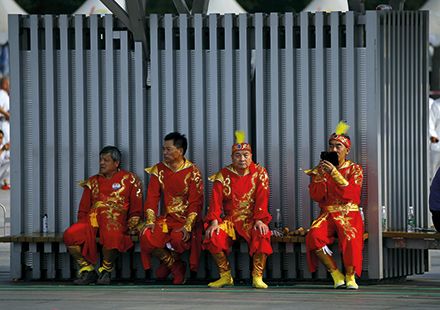Challenges to global growth, low commodity prices and volatile capital markets are piling the pressure on Asia in 2016. How vulnerable are Asia’s economies to a slowing China?
Worries over China’s slowing growth were at the centre of the turmoil in global markets at the start of 2016, as a slump in mainland stock markets compounded fears of waning demand from the world’s second-biggest economy.
A bleak outlook for China is a big problem for Asia, where many of the region’s economies rely on exports to China and are exposed to any reversal of global capital flows should foreign investors sound the retreat.
But recent news has been more positive, with stronger export figures for March adding to a rebound in investor confidence.
Having slid against the dollar in 2015, currencies across Asia’s emerging markets – including China – are showing signs of stability.
The ADB in late March downgraded its outlook for China’s GDP growth to 6.5% in 2016 and 6.3% next year, noting that the slowdown has dragged regional growth rates down by about 0.3 percentage points as a result of the strong linkages across Asia.
“It’s hard to discern a catalyst that would lift Asia from its middling growth rates. For this, structural reforms are needed. Only then will things begin to change, truly. And only then will a market rally be sustained.”
The bank, however, continues to argue that China can escape a hard landing as it rebalances its economy.
“China is in a natural slowdown after years of rapid growth, but a sharp fall is very unlikely,” said Shang-Jin Wei, the ADB’s chief economist.
“There are lots of issues to work on, but in a crisis China has a lot of tools it can use – both fiscal and monetary.”
The ADB has been a strong advocate of structural reforms in China for years, and Wei welcomes the progress that has been made in improving productivity and stoking domestic consumption.
In a release accompanying the bank’s Asian Development Outlook report, the ADB said the government’s “more gradual” approach to tackling overcapacity would help avoid more extreme fallout, noting that cutting capacity in the iron and steel, coal mining, cement, shipbuilding, aluminium, and flat glass industries by 20% might eliminate as many as 3.6 million jobs.
Wei sees recent moves in Chinese stock markets and the renminbi as little more than “noise” for investors. The inefficiencies in mainland capital raising mean that listed companies are not representative of the broader economy, while the currency has moved “a step closer to its fundamentals”.
Other economists broadly agree. Fitch expects growth of 6.2% in 2016 and 6.0% in 2017 but notes that China has the “financial and administrative resources to avoid a hard landing”. Analysts led by Andrew Colquhoun see the renminbi losing no more than 5% against the dollar in the remainder of 2016, according to an April report, but warn that rising leverage is adding to “systemic vulnerability”.
Temporary relief?
Morgan Stanley economists in March reported “encouraging signs of stabilisation” in China, while Barclays analysts revised up their below-consensus outlook for Chinese growth, noting the impact of stimulus policies.
In all cases, however, a more encouraging outlook on China comes with stern warnings that the rebound in market sentiment might not be sustainable.
“Without a fundamental change in the global economic environment – which we do not predict – the current episode is again likely to give way to one of higher volatility and spreading angst,” said Barclays economists led by Christian Keller in late March.
The IMF in April warned that risks to global growth “are now more pronounced”, citing a deeper slowdown in China and a return of financial turmoil as two of the greatest risks.
Wei at the ADB also cautions that the current period of calm may be short-lived, saying there is still a risk of a “surprise” on the scale or timing of US interest rate increases.
“In the last few weeks markets seem to have found a common ground in US rates, but this may be temporary relief,” said ADB’s Wei. “Countries need to focus on attracting FDI, not just portfolio flows.”
Frederic Neumann, co-head of Asia economics research at HSBC, notes that Asia has proved “remarkably resilient through the market turmoil over the past two years”. He does not see any immediate financial stress, but also warns that growth is still slowing.
“It’s hard to discern a catalyst that would lift Asia from its middling – and on a trend basis still decelerating – growth rates,” he said in an April note. “For this, structural reforms are needed: trade liberalization, state-owned enterprise reform, infrastructure investment, pruning of regulations that hamper competition, more spending on education and health care.
“Only then will things begin to change, truly. And only then will a market rally be sustained.”
To view all special report articles please click here and to see the digital version of this report please click here.
To purchase printed copies or a PDF of this report, please email gloria.balbastro@thomsonreuters.com.
